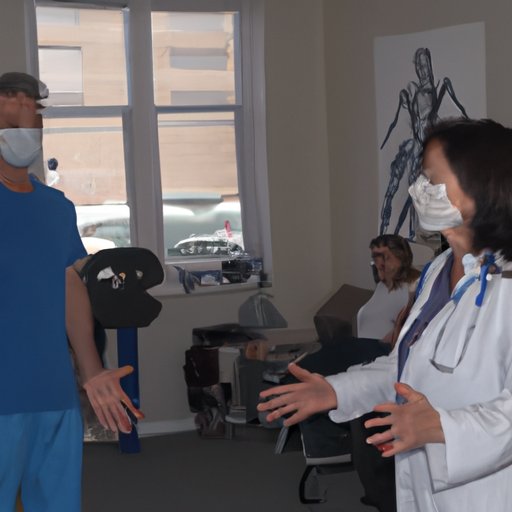Introduction
Wellness checks are a vital tool for ensuring the safety and wellbeing of individuals in our communities. Law enforcement agencies across the country perform millions of these checks every year, often at the request of concerned family, friends, or neighbors. While these checks are typically conducted with the best intentions, there are situations where they can cross the line into harassment, causing harm to the individual at the center of the check.
In this article, we will explore when a wellness check becomes harassment. We will discuss the boundaries of wellness checks, psychological impacts on victims, legal implications, strategies for balancing safety and privacy concerns, and the role of community education in prevention.
The Importance of Wellness Checks – Understanding the Definition and Boundaries
Wellness checks are typically conducted by law enforcement officers to ensure the safety and wellbeing of an individual, often in response to concerns from family, friends, or neighbors. They involve checking the individual’s physical and mental health, assessing their needs and resources, and connecting them with community services if necessary.
Definition of wellness checks
Wellness checks are a proactive step in ensuring the safety and well-being of individuals in the community. These checks are also known as welfare checks, and are performed by police officers or emergency personnel to verify the well-being of an individual when a request for assistance is made.
Wellness checks can be initiated by family, friends, or neighbors worried about an individual’s mental or physical health, or if the individual has been out of contact for an extended period. They can also be performed in response to a suicide threat, accident, or other emergency situations.
The boundaries of wellness checks
While wellness checks have a clear mandate to ensure safety and well-being, there are strict boundaries that need to be followed. For one, wellness checks should not be used as a pretext for invasion of privacy. Law enforcement officers should have reasonable suspicion or probable cause to face any intrusive measures.
Another boundary that law enforcement should respect during wellness checks is the right of the individual to refuse assistance. For instance, if the police come to perform a wellness check, the individual has the right to refuse any medical or psychiatric treatment unless they are posing an immediate threat to themselves or others.
The need for wellness checks
Wellness checks are a critical component of ensuring community safety. They help identify potential mental or physical health problems, connect individuals with resources and services, and bring peace of mind to concerned family and friends. Particularly for at-risk populations such as the elderly and disabled, wellness checks can be a lifeline of support.

When Does a Wellness Check Cross the Line: A Guide for Law Enforcement and Citizens
Despite their importance, wellness checks have the potential to cross the line and become sources of harassment and harm.
The different situations when wellness checks can turn into harassment
Wellness checks can potentially turn into harassment in several ways. For example, if law enforcement officers repeatedly perform wellness checks on an individual without reasonable cause, it can cause emotional distress for the individual. Additionally, wellness checks can turn into harassment by law enforcement officers if it involves an invasion of privacy, search, or seizure without warrant or probable cause, leading to feelings of powerlessness and entrapment.
How law enforcement can avoid harassment or perceived harassment
To prevent wellness checks from turning into harassment, law enforcement officers need to be aware of the boundaries outlined in the previous section. Officers should always have a specific request or reasonable suspicions to conduct a wellness check, execute any search, or seize any property. They should make sure that the individual is aware of the reason for the check and any other actions they intend to take. Officers should also make an effort to deescalate any potentially contentious situations, ensuring thorough communication with all parties involved.
What citizens can do when they feel harassed during wellness checks
Citizens who feel harassed during wellness checks have several options. For one, they can document the situation, including the officer’s name and badge number and request a copy of the report filed. They can also seek legal counsel to better understand their rights and potential remedies. Finally, they can submit complaints to the internal affairs division of the relevant law enforcement agency or to civil rights bodies such as the ACLU.
The Psychological Impacts of Unwanted Wellness Checks
The psychological implications of unwanted wellness checks can be profound and long-lasting, with the potential to engender significant emotional trauma and psychological harm.
The mental and emotional effects of unwanted wellness checks
Individuals who experience unwanted wellness checks may feel scared, anxious, or powerless. Trauma resulting from the incident can manifest in several ways, including feelings of helplessness, lack of control, and violation of boundaries. Unwanted wellness checks can also cause fear or anxiety in future situations involving law enforcement, leading to avoidant behaviours and an increased perception of threat.
The potential for trauma and victimization
Unwanted wellness checks may also exacerbate previous trauma or victimization experiences. For example, someone who has experienced sexual assault may experience unwanted wellness checks as a continuation of that breech of boundaries.
Recommendations for mitigating these effects
A key aspect of mitigating the psychological impacts of unwanted wellness checks is to validate the victim’s experience. Law enforcement officers can help by being respectful, empathetic, and supportive during wellness checks. Ensuring that the individual has adequate information regarding their rights and the police’s role during the wellness check is another important step.
Mental health services can also be a valuable resource for those experiencing the psychological impact of unwanted wellness checks, providing tools for managing anxiety and emotional distress.
Examining the Legal Implications of Wellness Checks and Harassment
Wellness checks can also have significant legal implications, making it essential to understand the legal framework surrounding these events and how to identify legal violations.
Understanding the legal framework of wellness checks and harassment
Wellness checks abide by the Fourth Amendment of the US Constitution, meaning they must follow strict standards and protocols to ensure safety without violating an individual’s privacy or Fourth Amendment rights. Law enforcement officers cannot enter a home or private property without permission, a warrant, or probable cause.
Harassment is a violation of civil rights laws and the Fourth Amendment’s protection against unreasonable searches and seizures. It is illegal for law enforcement to conduct unnecessary or overly repetitive wellness checks without cause or warrant, or to harass an individual during a wellness check.
How to identify legal violations in wellness checks
Several legal violations can occur during wellness checks, such as unauthorized searches, failure to obtain a warrant or consent, using excessive force, and other civil rights violations. Individuals should document and report any violations to the relevant law enforcement agencies and consult with legal counsel to pursue legal action if necessary.
The legal remedies available to victims of harassment during wellness checks
Victims of harassment during wellness checks have several legal remedies available, including filing complaints with the relevant law enforcement agency, filing a lawsuit, or filing a complaint with civil rights organizations.
Balancing Safety and Privacy: Exploring the Grey Area of Wellness Checks
Balancing safety and privacy concerns during wellness checks can be a complex and challenging process, with significant trade-offs and challenges for all parties involved.
The trade-offs between privacy and safety during wellness checks
Wellness checks involve delicate trade-offs between safety concerns and individual privacy rights. For example, law enforcement officers may need to conduct a search to ensure the individual’s safety. However, such searches must be reasonable and must not infringe unduly on individual privacy. Balancing these concerns requires careful planning and communication between all parties involved, often requiring sensitive and nuanced decision-making.
The challenges of maintaining safety while respecting privacy
Maintaining safety while respecting privacy during wellness checks can be challenging for law enforcement officers. They must be alert to the potential for danger posed by the individual, while at the same time being mindful of the emotional and psychological impact of the procedures on the individual.
Suggestions for balancing these concerns
To balance safety and privacy concerns during wellness checks, law enforcement officers can look for non-intrusive ways to assess an individual’s safety. They can also develop clear, concise protocols to ensure that privacy is protected. Additionally, officers can undergo training on proper search procedures and appropriate communication that is sensitive to the individual’s needs and values.
The Role of Community Education in Preventing Harassment during Wellness Checks
Education is a powerful tool in preventing harassment during wellness checks, providing a space for dialogue and understanding between law enforcement and the community.
The importance of community education on wellness checks and harassment
Community education is essential in fostering mutual understanding and cooperation between law enforcement officers and the community they serve. Education can help raise awareness of privacy rights, legal boundaries, and the emotional and psychological impacts of wellness checks.
Strategies for educating the public and law enforcement
Community education can occur in several ways, including seminars, workshops, and community meetings. Law enforcement officers can hold educational sessions in the community, engaging in dialogues and building rapport with the community.
Examples of successful community education efforts
Successful community education efforts include programs such as community policing, which helps build trust and open communication between officers and the public. Such programs can help in fostering a more positive interaction between communities and law enforcement, helping to prevent unnecessary harm and harassment.

The Need for Clear Standards and Procedures for Wellness Checks
Clear standards and procedures for wellness checks can help prevent harassment and ensure the safety and well-being of everyone involved.
The importance of clear standards and procedures for wellness checks
Clear standards and procedures for wellness checks can prevent legal violations and misunderstandings, helping law enforcement officers perform these checks safely and responsibly. It can also aid in building trust within communities, reduce anxiety, and provide a sense of confidence that these checks will be handled appropriately.
Examples of current best practices
Some current best practices include following strict protocols for obtaining warrants, conducting searches, and communicating with individuals during wellness checks. Additionally, law enforcement officers can undergo specialized training to better understand mental health and crisis intervention, improving their ability to perform wellness checks safely and effectively.
Recommendations for improving standards and procedures
Several recommendations can aid in improving standards and procedures for wellness checks. These include creating a community-led task force on wellness check procedures, developing a list of community resources and services available to individuals in crisis, and establishing regular communication channels between law enforcement and the community.
Conclusion
In conclusion, wellness checks are a vital tool for ensuring community safety, providing a means to determine an individual’s safety and connect them to needed resources. However, these checks can cross the line into harassment and harm. To prevent this from happening, all parties involved, including law enforcement and citizens, need to be aware of the legal and psychological implications of wellness checks. We can achieve better, safer, and more empathetic wellness checks by following the recommendations outlined in this article and working together as a community to ensure safety and respect for individual dignity.
Join us in advocating for better wellness check procedures, building trust between communities and law enforcement, and ensuring the safety and wellbeing of everyone in our communities.
